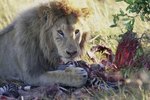
Don't let their rotund appearance and vegetarianism fool you. A threatened hippo is a dangerous killing machine, and will aggressively attack any creature he deems a danger to himself or others. About as large as a rhinoceros, a hippo is equipped with powerful defense mechanisms that he never needs for hunting -- only for self-protection.
Warding Off Foes
While a hippo only eats plants, his mouth is full of big, intimidating teeth. One of the reasons they're so big is so that they'll intimidate foes. When a hippo is approached by a threat, he opens his mouth wide to display his teeth as a warning against attack. They even do this to each other before a fight -- typically, whichever one realizes that he is outmatched will retreat before they come to blows.
Jaws That Crunch
Hippos don't need particularly strong jaws to chew the plants that make up their diets, but they have them anyway. A hippo's jaws are extremely powerful, making them a distinctly dangerous animal to take on. For example, a hippo can literally bite a crocodile in half with his jaws, or take apart an attacking lion. They may not look like it at first, but hippos are vicious when they need to be (See References 1).
Head and Teeth
Hippos don't just bite their opponents when defending themselves -- they use their massive size to their advantage, too. A hippo engaged in battle will actually use his head to bludgeon his enemies, sometimes releasing an intimidating war cry as he does. Other times, he'll use his sharp tusks as spear-like instruments for goring and slashing away at his opponent.
In the Herd
Hippos protect themselves by living in groups called herds, which can be between 10 and 30 hippos in size. The animals have an established hierarchy within the herd, and while sometimes that can lead to fighting among the group, they generally stick together and protect their own.
References
Photo Credits
-
Ablestock.com/AbleStock.com/Getty Images
Writer Bio
Tom Ryan is a freelance writer, editor and English tutor. He graduated from the University of Pittsburgh with a degree in English writing, and has also worked as an arts and entertainment reporter with "The Pitt News" and a public relations and advertising copywriter with the Carnegie Library of Pittsburgh.




